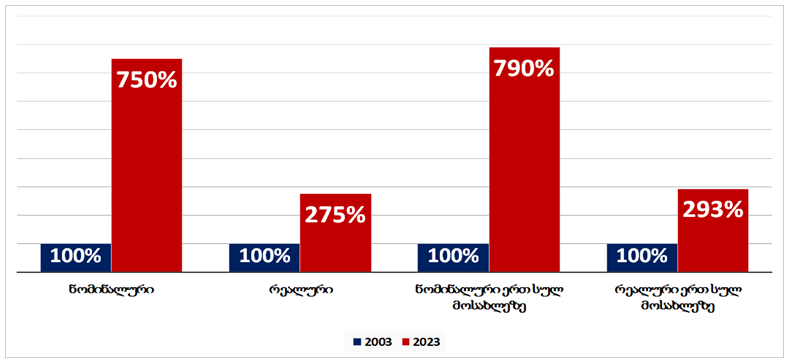Vasil Urushadze: “During the governance of the United National Movement political party, the GDP per capita was increasing at a rate threefold higher.”
Verdict: FactCheck concludes that Vasil Urushadze’s statement is FALSE.
The GDP grew by approximately 6.1% annually with the GDP per capita experiencing an annual growth of 6.8% during the United National Movement’s governance from 2004 to 2012 (the difference is attributed to a declining population). Following the change in government in 2013-2023, the GDP growth rate decreased to 4.4%, indicating that this rate during the United National Movement government exceeded that of the Georgian Dream political party government by merely 1.39 rather than threefold whereas the GDP per capita growth rate was higher by 1.55.
Context is crucial for accurate comparisons as the global economy witnessed a higher growth in 2004-2012 as compared to 2013-2023. Moreover, the economies of all four of Georgia’s neighbouring countries also witnessed a reduced growth.
Vasil Urushadze employs a misleading methodology by comparing nominal growth rates without accounting for inflation and exchange rate fluctuations, leading to a doubled advantage. Additionally, he provides misleading figures for GEL-denominated data resulting in an overstated achievement of growth during the United National Movement’s governance and an understated achievement of the Georgian Dream’s governance. Furthermore, he omits the year 2023 when the Georgian GDP grew at an above-average rate of 7% and fails to acknowledge the context that GDP growth rates reduced not only regionally but also globally.
Given Vasil Urushadze’s use of an incorrect methodology, an overstated advantage, a lack of context and the omission of data for 2023, FactCheck concludes that his statement is FALSE.
Analysis:
The Secretary of the United National Movement Anti-Corruption Council, Vasil Urushadze, posted a Facebook message stating: “During the governance of the United National Movement political party, the GDP per capita was increasing at a threefold higher rate.” The accompanying description claimed: “The GEL-denominated nominal GDP grew by 3.37 in 2003-2012 and 2.53 in 2013-2022. In USD-denominated nominal GDP per capita, the growth was by 4.38 in 2003-2012 and by 1.44 (44%) in 2013-2022.”
The GDP per capita can be calculated in various ways, including denominating values in the local currency or USD, using nominal or purchasing power parity (PPP) approaches and considering current or fixed prices.
Inflation can distort the actual growth picture, resulting in overestimated interpretations. Moreover, changes in exchange rates also portray similar or sometimes the opposite results. It is crucial to use the multiplied real GDP annual growth rate to accurately assess the volume of growth of the economy in a certain time period.
For an expanding population, the GDP per capita growth rate is lower than that of the entire country and conversely, the opposite is true for a declining population.
The nominal GDP in Georgia in grew from USD 4 billion to USD 30 billion, constituting a 7.5-fold surge from 2003 to 2023. Whilst calculating the GDP per capita, the figure rose from USD 1,030 to USD 8,160, suggesting a 7.9-fold change.
However, the real growth of the economy did not match these nominal figures. When adjusting for 2015 prices, the economy grew from USD 7.84 billion to USD 21.6 billion, representing a 2.75-fold change whereas the GDP per capita grew from USD 1,985 to USD 5,280, constituting a 2.93-fold change in the same period.[1]
Graph 1: Nominal and Real Growth Over Time in Georgia (2003=100%)

Source: World Bank
The GDP per capita outpaced that of the entire country in terms of current or fixed prices as the population decreased by 230,000, reaching a total of 3.7 million.
Graph 2: Population (Thousand Persons)

Source: National Statistics Office of Georgia
The average annual growth rate of the economy totalled 6.
1% during the United National Movement’s governance from 2004 to 2012 whilst it decreased to 4.4% during the Georgian Dream’s governance from 2013 to 2023. Similarly, the growth rates for the GDP per capita were 6.8% and 4.4%, respectively. Whilst both 6.1 and 6.8 exceed 4.4[2], the actual growth is merely 1.39-fold (and 1.55-fold on a per capita basis) and not threefold as stated by Vasil Urushadze.
Vasil Urushadze asserts that GEL-denominated GDP per capita grew 3.37-fold from 2003 to 2012 and 2.53-fold from 2013 to 2022. The GDP per capita was GEL 2,167 in 2003 and GEL 7,018 in 2012 according to GeoStat, suggesting a 3.24 growth. Moreover, the GEL-denominated GDP per capita grew from GEL 7,220 to GEL 19,465 in 2013-2022, indicating a 2.70 growth. The choice of fixing for 2013 instead of 2012 is unclear. Moreover, the figures do not accurately represent the reality even in this case. Despite the overstated advantage in the initial period and the understated growth in the following period, the primary inaccuracy comes from the methodology where inflation was not taken into account.
A similar picture is observed for USD-denominated calculations. The GDP per capita grew from USD 1,030 to USD 4,420, by 4.4 in 2003-2012, and from USD 4,620 to USD 6,675 in 2013-2022, according to World Bank data. Despite the accurate use of nominal figures, the methodology is twice flawed as both inflation and exchange rate fluctuations are omitted.
In addition to methodological and factual inaccuracies, the context should also be taken into account. An individual economy cannot evolve independently as it is significantly influenced by regional and global occurrences.
All four of Georgia’s neighbouring countries, as well as the rest of the world, experienced higher economic growth from 2004 to 2012 as compared to the subsequent period spanning 2013 to 2023.
Graph 3: Average Annual Growth Rate of the Economy

Source: World Bank
Whilst it is true that the economy grew at a higher rate during the United National Movement’s governance as compared to the subsequent period of the Georgian Dream’s governance, similar patterns are observed in all four of Georgia’s neighbouring countries and globally where the average annual growth rate from 2004 to 2012 generally exceeds that of the years spanning 2013-2023.
Vasil Urushadze employs an inaccurate methodology by relying on nominal terms for comparison, neglecting changes in inflation and the exchange rates, resulting in a doubled interpretation of the advantage. Additionally, he provides inaccurate figures for GEL-denominated calculations leading to an overestimated growth during the United National Movement’s governance and an underestimated growth during the Georgian Dream’s governance. Moreover, he omits 2023 trends from the discussion and fails to acknowledge the context that the GDP growth rate reduced regionally and globally during the aforementioned period.
Although the growth rate decreased following the change in government, the reduction did not amount to a threefold decrease. The annual growth rate during the United National Movement’s governance exceeded that of the observed value during the Georgian Dream’s governance by 1.36 and by 1.55 on a per capita basis, implying that Vasil Urushadze’s claims regarding the advantage were double the actual amount. He is only accurate by stating that the overall average annual growth rate during the United National Movement’s governance exceeded that of the Georgian Dream’s; however, due to his use of incorrect methodology, overstating the advantage, miscalculations and lack of context, FactCheck concludes that Vasil Urushadze’s statement is FALSE.
[1] The World Bank has not yet released the data for 2023 as of February 2024, however, according to GeoStat, the Georgian economy expanded by 7% in 2023. The 2022 figures (USD 5,440 per capita and USD 20.2 billion for the country) have been increased by 7% each in the calculations.
[2] The population witnessed a reduction in the years from 2003 to 2012. However, population growth in 2023 is attributed to a positive net migration in 2022. The Georgian population experienced a negative net migration of 46,000 in 2022. In the following year, the positive net migration reached 55,000, mainly driven by Russian as well as Ukrainian and Belarusian citizens.








